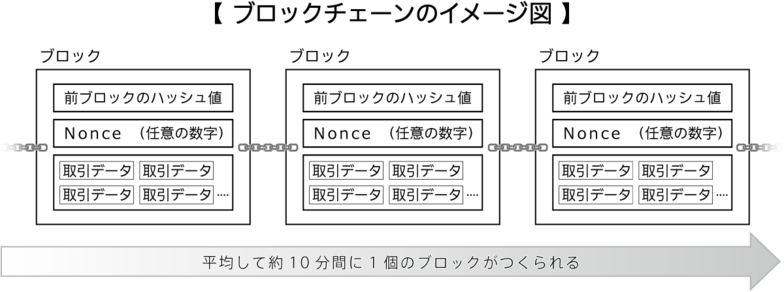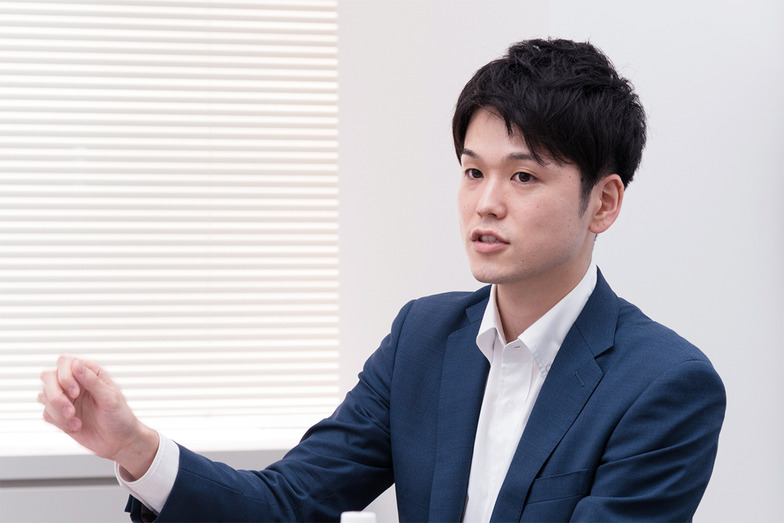When you hear "FinTech," many people probably think of cryptocurrencies like Bitcoin. While Bitcoin brought the technology "blockchain" into the spotlight, a crucial point for correctly understanding blockchain is that it is not a technology limited to cryptocurrencies or the financial industry. The potential domestic market size for blockchain technology is now estimated at around 70 trillion yen*, and its market impact, regardless of whether it's in the financial or non-financial sectors, is immeasurable.
Here, Toshihiro Hasamura of Dentsu Inc.'s Business Creation Center invited Professor Kenji Saito, a leading Japanese authority on blockchain technology and Senior Researcher at Keio University's SFC Research Institute, along with Yuki Yamashita, the technical lead for blockchain proof-of-concept experiments at Dentsu Inc. International Information Services (ISID), to discuss blockchain as a foundation that could transform the world. What innovations could blockchain enable?
*Source: Ministry of Economy, Trade and Industry "Survey on Domestic and International Trends in Services Utilizing Blockchain Technology"

From left: Kenji Saito, Yuki Yamashita, Toshiaki Hasamura
Blockchain = Users holding perfectly identical information
Hasumura: First, it's an honor to have Professor Saito here at FINOLAB Inc. Professor Saito has authored books such as "Bitcoin Made Clear: The Conditions for a Currency to Survive" (Tarojirōsha Editus) and "The Impact of Blockchain" (Nikkei BP / co-authored). When did you begin researching digital currencies?
Saito: I originally worked as an engineer at Hitachi Software (now Hitachi Solutions), developing computer operating systems. Then, starting in 2000, I moved to Keio University's SFC, where I've continued researching "Internet and Society," including "digital currency."
Hasamura: First, what exactly is "blockchain," the technology used in Bitcoin and similar systems? I'd like Professor Saito to explain this clearly. Cryptocurrencies like Bitcoin have a feature called a public ledger, which contains the "complete transaction history, including past transactions," and all users can verify it. Is blockchain the technology that establishes this mechanism?
Saito: Yes. Each digital transaction occurring worldwide—such as "A sending X amount of coins to B"—is stored in a block, a unit of recorded data. A single block contains around 1,000 digitally signed entries like "A sent Y coins to B," forming a chain-like structure. By embedding the previous block's hash value into the next block, the contents of the preceding block are locked.

Saitō: The interesting aspect of digital currencies like Bitcoin is that they ensure record integrity not through a centralized system where banks or governments hold the original information and distribute copies, but by having all users hold the same information.
Yamashita: If data is concentrated in one location, it's all over if that location is destroyed. But with blockchain, every single user holds the same information. Theoretically, the system won't go down unless every computer participating in the network is destroyed. This is evident from the fact that even if one Bitcoin exchange fails, Bitcoin itself continues to be used through other exchanges.
Hasumura: Couldn't someone write false information into the ledger to commit fraud?
Saito: To prevent that, technologies like digital signatures and "hash values" are used. Users mutually possess information whose contents are transparent, preventing fraud. And if it's guaranteed that the records are perfectly identical among users, it can be used as currency with confidence.
Yamashita: Even if someone were to alter a record, other users can immediately verify its authenticity through digital signatures, exposing any tampering.
Saito: Because it guarantees that everyone possesses identical data, blockchain is a technology with potential applications beyond finance, across various fields.

Bitcoin's blockchain cannot enable instant payments
Hasumura: Then, could you tell us about the current issues with blockchain?
Saito: When multiple blocks are linked together, forks can occur. For example, suppose conflicting double entries appear on the blockchain: "Person A, who holds 500 Bitcoin, sent 500 Bitcoin to Person B, but also sent the same 500 Bitcoin to Person C." In this case, the principle that "the longest chain is valid" means one chain will eventually disappear, but this process takes time. In other words, the determination of settlement completion, known as "finality," cannot be made immediately and, strictly speaking, may never be achieved.

The longest blockchain becomes valid
Yamashita: A common example is the "drone vending machine" story.
Saito: Exactly. Imagine developing a vending machine where a drone delivers a can of juice to the person who paid. If you pay with Bitcoin via your smartphone, that drone has to drop the juice can, right?
But if we wait until the payment is probabilistically safe—meaning it's confirmed across six subsequent blocks—the drone can't drop the juice until then. Since blocks average about 10 minutes each, if we're meticulous, that means an hour. The drone stays airborne, and the payer never gets their juice.
Hasumura: That means you can't drink the canned juice when you want it.
Saitō: In reality, the can of juice would likely be dropped immediately. The business might lose the value of one can, but taking that risk is necessary for the business to function. If it took an hour from someone thinking "I want a can of juice" to it landing in their hands, that business wouldn't work. So, the juice gets dropped before it enters the blockchain chain.
Hasumura: This becomes a problem when it's not just a can of juice, but a higher-value transaction.
Yamashita: Some new blockchain technologies, different from Bitcoin's, do incorporate finality mechanisms. Changing the subject, in June this year, "The DAO" – an autonomous decentralized investment fund built on Ethereum, a platform capable of handling any asset or contract on the blockchain – faced a crisis when it was attacked by hackers, resulting in the loss of $50 million (approximately ¥5.2 billion). It was an incident that sent shockwaves through the industry...
Saito: Ethereum is a blockchain built based on lessons learned from Bitcoin. "The DAO" was an investment vehicle, similar to a mutual fund, built on this Ethereum platform, where participants decided where to invest. A bug in The DAO allowed funds to flow to the perpetrator, causing Ethereum's currency price to plummet. Subsequently, developers considered the option of extending a "correct history" that diverged from the leaked blockchain. This "correct history" was approved with the support of 97% of the community. While this decision gained strong community support, it highlights a potential issue: despite being called autonomous and decentralized, the developer community and miners (those who "mine" new currency with computers) could potentially hold enough power to correct distorted history. In a way, isn't this somewhat centralized...?
Hasumura: So, the development community and miners might potentially hold the power to nullify past actions.
Saito: Exactly. It raises questions about whether it truly functions as a decentralized system. For example, email initially only supported English. Non-English text was treated as "cryptography" and discouraged. But Japanese developers experimented, enabling Japanese transmission using JIS code. Now, languages worldwide are supported. Technology should evolve through experimentation by various engineers, refining itself based on real-world results.

Printing and seals are all replaceable
Hasumura: Beyond cryptocurrency, how else can blockchain be applied? For instance, when we enter a contract, we typically prepare two written copies, verify them, affix seals, and keep one copy each. Does blockchain technology prove useful in such non-financial scenarios too?
Saito: Contracts are a perfect example. All the actions we've traditionally performed on paper—printing, affixing seals, or signing—can be replaced with "digital" equivalents. We're right in the middle of this transition. While it's unclear if blockchain will replace all these processes, it's certainly a strong candidate among current technologies.
Hasamura: Mr. Yamashita, I understand ISID has been quick to conduct proof-of-concept experiments using this blockchain technology with Mizuho Financial Group.
Yamashita: Yes. With Mizuho Financial Group, we're conducting a proof-of-concept focused on syndicated loan operations (where multiple financial institutions collaborate to provide a single loan). One reason we selected syndicated loans is because they involve many parties and have complex workflows. We want to assess how well blockchain, still a relatively new technology, can actually be applied to these operations. Based on that, we'll explore its potential use in other business areas as well.
Recently, we've also seen many clients outside the financial sector expressing interest in blockchain. As ISID's technology lead, I'm working with these companies to explore how blockchain can be effectively utilized for their specific needs.

Hasumura: So, tasks beyond just money transfers might also be replaceable with blockchain, right?
Yamashita: Yes. The Ethereum blockchain, mentioned earlier, enables a mechanism called "smart contracts," which can handle everything from issuing contracts to transferring assets. Beyond just money transfers, blockchain also holds high potential for automating tasks like identity verification—previously done using passbooks and seals—and transaction reconciliation, which used to require multiple steps across several companies. We believe this could significantly reduce the enormous costs associated with these processes.
Hasumura: Thank you. In the second part, we'll delve deeper into which specific industries blockchain will be used in and how it will transform society.






 From left: Kenji Saito, Yuki Yamashita, Toshiaki Hasamura
From left: Kenji Saito, Yuki Yamashita, Toshiaki Hasamura



